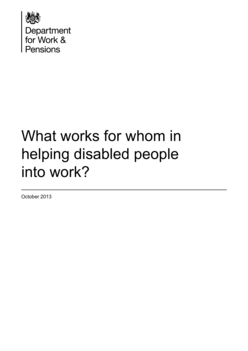Hello! You're looking at a policy document report on Overton
We track government policy, guidelines, think tank research, working papers and more to help our customers see the impact and influence of their work. Are you interested in seeing what information we have to offer? Request a free trial to our platform.
If you fund, produce or manage research or work to influence policy, we'd love to talk. Learn more on our homepage.

What works for whom in helping disabled people into work? (WP120)
Topics in this document
Related SDGs
Target 8.5
Achieve full and productive employment and decent work for all women and men, including for young people and persons with disabilities, and equal pay for work of equal value
Citations
Rights & Permissions
Uses license: Open Government Licence
Content from GOV.UK is subject to Crown copyright protection and is published under the Open Government Licence (OGL)
